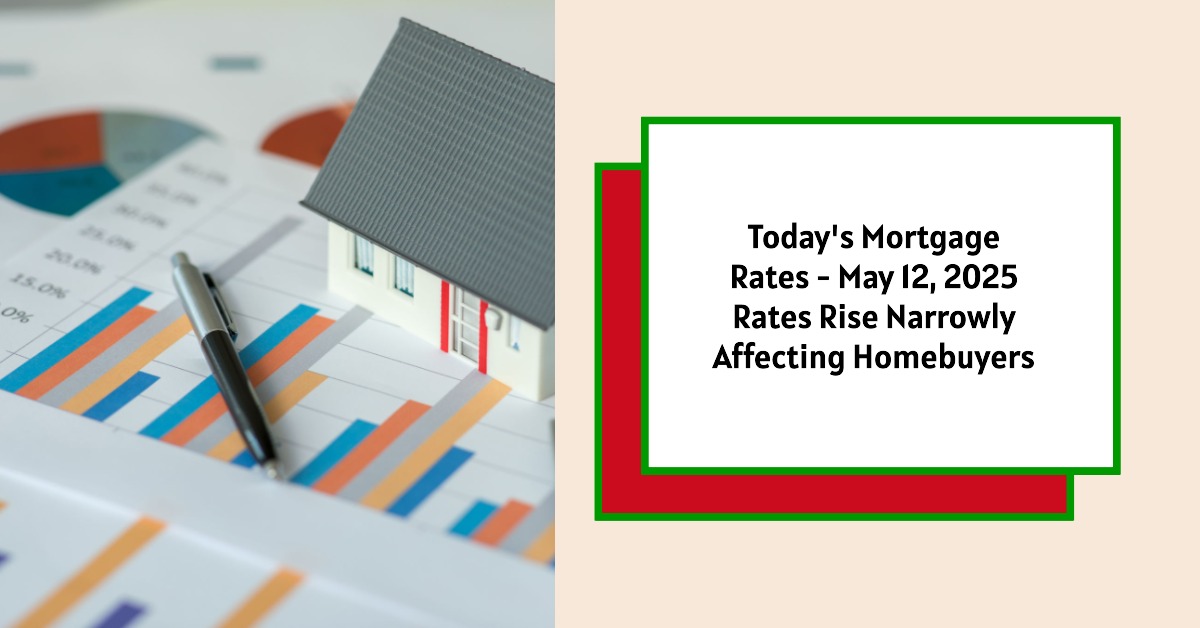As of May 12, 2025, mortgage rates are hovering around the high 6% range, with the average rate for a 30-year fixed mortgage at approximately 6.80%. These rates reflect ongoing economic dynamics and fluctuations driven by variables such as inflation data and broader market trends. For borrowers and potential homebuyers, understanding these rates is essential for making informed decisions in today’s housing market.
Today's Mortgage Rates – May 12, 2025: Rates Rise Narrowly Affecting Homebuyers
Key Takeaways
- Mortgage rates are currently around 6.80% for a 30-year fixed mortgage.
- Refinancing rates are also aligned with mortgage rates, averaging 6.87%.
- Upcoming inflation data may cause slight fluctuations in these rates.
- Adjustable-rate mortgages (ARMs) currently have higher rates compared to fixed rates.
Current Mortgage Rates Overview
Here's a detailed look at today's average mortgage rates from Zillow across various products:
| Mortgage Type | Average Rate (%) |
|---|---|
| 30-Year Fixed Mortgage | 6.80% |
| 20-Year Fixed Mortgage | 6.19% |
| 15-Year Fixed Mortgage | 6.08% |
| 7/1 ARM Mortgage | 7.39% |
| 5/1 ARM Mortgage | 7.06% |
| 30-Year FHA | 5.95% |
| 30-Year VA | 6.36% |
Current Refinance Rates
If you're considering refinancing, here’s the latest on refinance rates from Zillow:
| Refinance Type | Average Rate (%) |
|---|---|
| 30-Year Fixed Refinance | 6.87% |
| 20-Year Fixed Refinance | 6.29% |
| 15-Year Fixed Refinance | 6.15% |
| 7/1 ARM Refinance | 7.69% |
| 5/1 ARM Refinance | 8.00% |
| 30-Year FHA Refinance | 5.75% |
| 30-Year VA Refinance | 6.50% |
Understanding Mortgage Rates
Mortgage rates are a decisive aspect of the home buying process. They determine how much interest you will pay over the life of your loan, significantly impacting your financial situation. The widely favored 30-year fixed mortgage allows homeowners to enjoy predictable monthly payments over a long duration. This predictability means that despite market fluctuations, your payment remains stable.
However, some buyers may opt for a 15-year fixed mortgage as a way to save on interest payments over the life of the loan, even though it requires higher monthly payments. ARMs can also be appealing due to lower initial rates; however, they come with the risk of rate adjustments after the initial period, which may increase monthly payments if interest rates rise.
Factors Influencing Mortgage Rates
Several factors influence mortgage rates, including:
- Economic Indicators: Key indicators such as unemployment rates and inflation figures play a vital role. If inflation rises beyond expectations, it generally leads to increased mortgage rates as lenders need to account for the decreased purchasing power over time.
- Federal Reserve Policies: The actions of the Federal Reserve, particularly regarding the federal funds rate, can influence mortgage rates. While rates are not directly tied to the federal funds rate, they often follow trends based on investor perceptions of future interest rate movements.
- Housing Market Dynamics: The balance of supply and demand in the housing market also plays a fundamental part. If housing inventory remains low, prices and corresponding mortgage rates can be pushed higher, further complicating the environment for first-time buyers.
Recent Market Trends
Recent data suggests that mortgage rates have shown some stability recently, reflecting a degree of investor confidence despite lingering economic uncertainties. Inflation data released this week will be closely monitored, as changes in consumer prices can directly impact lending decisions.
According to reports from sources like Zillow and Freddie Mac, today's trends indicate that while rates are elevated, they are not experiencing the extreme fluctuations seen in earlier years. The average rate for a 30-year fixed mortgage has consistently remained around 6.80%, striking a balance that could represent a new normal for borrowers.
Read More:
Mortgage Rates Trends as of May 11, 2025
Dave Ramsey Predicts Mortgage Rates Will Probably Drop Soon in 2025
Future of Mortgage Rates Post-Fed Decision: Will Rates Drop?
Fed's Decision Signals Mortgage Rates Won't Go Down Significantly
Economic Influence on Rates
As we look deeper into economic predictions, the inflation rate is projected to rise slightly, estimated to reach 2.3% for April. This uptick could lead to a reassessment of the mortgage market, especially if it considerably deviates from past data. As a homeowner or a prospective buyer, staying attuned to these economic indicators can help you anticipate changes in mortgage rates.
For individuals contemplating refinancing, the current rates suggest a cautious yet strategic approach. Refinancing may still be worthwhile if you can secure a rate significantly lower than your existing one.
Mortgage Payment Implications
When budgeting for a mortgage, it's critical to account for both the interest rate and the potential monthly payments. For example, if you were to take out a $400,000 mortgage at a 6.80% interest rate, your monthly payment would be around $2,585, excluding additional costs such as property taxes and homeowners insurance. It's essential to factor these costs into your overall financial strategy.
To better understand how varying rates affect your financial planning, consider the cumulative cost of a mortgage. A lower rate not only reduces monthly payments but can also lead to significant savings over the term of the loan. As an example, locking in a lower rate today could save you tens of thousands of dollars in interest over the life of the loan, making your home more affordable in the long run.
Mortgage Rate Projections for 2025
Looking ahead, industry experts anticipate that mortgage rates will likely decrease gradually throughout 2025, influenced largely by economic health. If the inflation continues to be tempered by government measures or if we experience slower economic growth, mortgage rates could decline even more. However, caution is warranted, as unpredicted economic events could lead to sudden increases.
As the year progresses, it's advisable to keep an eye on the Federal Reserve’s actions and any significant economic reports. Understanding these factors can help potential homebuyers and those considering refinancing make more informed choices amidst changing market conditions.
Conclusion
In summary, as of May 12, 2025, mortgage rates are stable, remaining in the high 6% range. Both homebuyers and those looking to refinance should stay informed of economic trends and their potential impact on lending rates. By understanding current conditions and potential future movements, you can navigate this crucial decision-making period more confidently.
Invest Smarter in a High-Rate Environment
With mortgage rates remaining elevated this year, it's more important than ever to focus on cash-flowing investment properties in strong rental markets.
Norada helps investors like you identify turnkey real estate deals that deliver predictable returns—even when borrowing costs are high.
HOT NEW LISTINGS JUST ADDED!
Connect with a Norada investment counselor today (No Obligation):
(800) 611-3060
Also Read:
- Will Mortgage Rates Go Down in 2025: Morgan Stanley's Forecast
- Expect High Mortgage Rates Until 2026: Fannie Mae's 2-Year Forecast
- Mortgage Rate Predictions 2025 from 4 Leading Housing Experts
- Mortgage Rates Forecast for the Next 3 Years: 2025 to 2027
- 30-Year Mortgage Rate Forecast for the Next 5 Years
- 15-Year Mortgage Rate Forecast for the Next 5 Years
- Why Are Mortgage Rates Going Up in 2025: Will Rates Drop?
- Why Are Mortgage Rates So High and Predictions for 2025
- Will Mortgage Rates Ever Be 3% Again in the Future?
- Mortgage Rates Predictions for Next 2 Years
- Mortgage Rate Predictions for Next 5 Years
- Mortgage Rate Predictions: Why 2% and 3% Rates are Out of Reach
- How Lower Mortgage Rates Can Save You Thousands?
- How to Get a Low Mortgage Interest Rate?
- Will Mortgage Rates Ever Be 4% Again?



